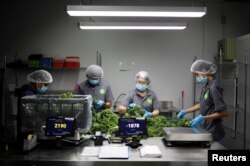Big changes in agriculture are taking place in Singapore. Some people say the small, Southeast Asian nation is leading a farming revolution.
Singapore aims to increase its own food production by growing vegetables on top of office buildings. It also has set up tiered fish farms and is using laboratories to grow shrimp, a popular treat. That way, the island nation will not have to depend as much on imports to feed its 5.6 million people.
Singapore produces about 10% of its food. But as climate change and population growth threaten food supplies, it wants to raise that to 30% by the year 2030, under a plan known as ‘30-by-30’.
The problem is space.
Singapore is a small country, with only 724 square kilometers of land. Only one percent of that land area is used for agriculture. Food production costs are higher there than the rest of Southeast Asia. The pressure is on new farmers to answer the government’s call to “grow more with less.”
“Whenever I talk about food security in Singapore, I tell folks don’t think land - think space. Because you can go upwards and sideways,” said Paul Teng. He is an agriculture professor at Nanyang Technological University. He spoke with the Reuters news agency.
There are more than 30 vertical farms in Singapore — ones that grow up, not across, the land. The number of so-called “sky farms” has doubled over the past three years.
Sustenir Agriculture is one of these businesses. Its hydroponic farm grows non-native foods like kale, cherry tomatoes and strawberries inside buildings under artificial lighting. Then it sells the produce to local supermarkets and online stores.
Sustenir raised $16 million from investors last year. The money will be used to expand operations in Singapore and open in Hong Kong.
Some of that money came from Singapore state investor Temasek. It is also providing financing to Apollo Aquaculture Group, which is building a highly-automated, eight-story fish farm. The project is expected to cost about $50 million.
Apollo produces 110 tons of fish each year. It says the new fish farm will mean it can provide 20 times that amount.
“It is too unpredictable to do things now in the traditional way,” said Apollo chief Eric Ng. In recent years, there have been problems with algae blooms killing off farmers’ fish.
Singapore’s government plans to build an 18-hectare agriculture area for indoor plant factories and insect farms by the middle of 2021. Some people get protein by eating insects.
The plan was first announced in March. Government officials have yet to say how much the ‘30-by-30’ plan will cost.
Not everyone thinks the new technology is best.
Egg farmer William Ho says the government should not depend so much on agriculture technology businesses.
“Many of them have failed. That’s why I’m always asking the government why don’t you invest in us old-timers. We are more practical,” he said.
Professor Paul Teng said an issue for urban farmers is that the high cost of the technology makes their products too pricey for many people.
One new business is Shiok Meats. It aims to be the world’s first to sell shrimp grown from cells in a laboratory.
The process involves cells grown in a nutrient solution in tanks. After four to six weeks, the fluid is removed, leaving small pieces of shrimp. The company says the process is harmless to animals.
Shiok Meats plans to sell its product in one or two top restaurants by late 2020. By 2030, it hopes to produce enough shrimp meat to feed Singapore.
I’m Jill Robbins.
The Reuters news agency reported this story. Anne Ball adapted the story for VOA Learning English. George Grow was the editor.
_____________________________________________________________
Words in This Story
tier – n. a row or layer of things that is above another row or layer
folks – n. plural, unofficial term for people in general
hydroponic – adj. a method of growing plants in water
artificial – adj. not natural or real; made, produced, or done to seem like something natural
online – adj. connected to or served by a computer or telecommunication system
automated – adj. to run or operate by using machines or computers, instead of people to do the work
algae bloom – n. a sudden increase of algae population in water, sometimes harmful to humans, marine or freshwater environments
practical - adj. relating to what is real as opposed to what is possible or imagined
urban – adj. of or related to a city
What do you think of indoor farms? We want to hear from you. Write to us in the Comments Section.











